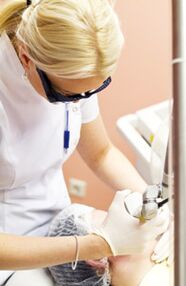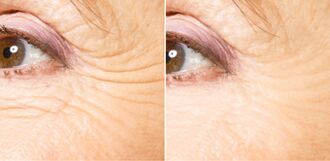
Skin aging begins at the age of 25, and at first this process goes unnoticed.Meanwhile, the skin gradually loses its elasticity, its structure changes, it becomes looser, pores enlarge and wrinkles appear.Sooner or later, suddenly the time changes become visible, and then it becomes difficult to cope with them with ordinary cosmetic products.And pigmentation disorders and skin thinning cannot be corrected at all with conservative methods.
Fortunately, modern technology does not leave us alone with the problem of fading.To restore youthful skin, it is not enough to eliminate existing defects and signs of aging;It must be stimulated and the cell renewal process launched in it.This is the only way to achieve not only a visual effect, but also real facial rejuvenation.Fractional laser facial skin rejuvenation, which has been used in cosmetology for more than 10 years, can solve the problem.
This technology is based on the method of fractional photothermolysis - exposure to a laser beam of a certain length, divided into several streams of light (fractions) for more efficient operation.Today, fractional rejuvenation is considered a real alternative to surgical facelift.
The mechanism of action of laser fractional skin rejuvenation
Over time, all processes in the body slow down, including at the cellular level.This is what causes skin aging: cells are no longer recycled quickly, new ones do not grow actively, as a result, skin renewal occurs more ineffectively and practically stops.Studies have shown that laser irradiation of the cells helps restore the skin's potential for natural rejuvenation.
Under the influence of light beams and thermal shocks produced in the skin, intensive tissue cleansing occurs dead cells and those whose ability to continue to grow and develop are lost.At the same time, young and healthy cells only benefit from such an effect: they actively multiply, replace used cells and restore the "damaged" skin renewal mechanism.
Almost all cosmetic lasers have this effect on the skin of the face.The difference between Fraxel is that it uses the most effective laser beam size, with a diameter of less than 200 microns: it is a thin laser that contributes the most to the replacement of old tissue with young and healthy ones.
The second feature of fractional rejuvenation is that the effect does not occur with one beam, but with the total mass of micro-rays into which the light flux is divided, creating a grid effect.Therefore, the irradiation occurs not pointed or as a continuous pulse.It is located according to a certain matrix.
The skin is divided into small areas, in the center of each of which there is tissue that has experienced a strong thermal shock, and around it are healthy cells that are not affected by the laser beam.The result of this treatment is active skin regeneration: the exfoliation of damaged cells and the growth of new skin in their place.
Fractional type of rejuvenation
Fractional photothermolysis exists in two fundamentally different forms: ablative and non-ablative.These laser treatment methods differ from each other in many features: laser penetration depth, treatment intensity, skin stimulation mechanism, and final effect.
Ablative technology involves superficial effects on epidermal cells through their evaporation.Non-ablative rejuvenation, on the other hand, does not affect the top layer of the skin, but penetrates deep into it, where the lower layer of the epidermis lies and the dermis begins.In this case, the irradiated cells do not evaporate, but form a column of coagulated tissue.
In both cases, the laser treatment takes place in a limited area, where the location with the cellular programming zone is preserved - healthy cells that have a great potential for regeneration, which is triggered by heat shock.A short-term increase in temperature in the tissue causes the activation of all metabolic processes in it, including the growth of elastin and collagen fibers, which are responsible for the elasticity and youth of the skin.
Ablative Fraxel gives a quick effect and is more suitable for eliminating the first signs of aging: shallow wrinkles, slight loss of turgor.As a result of ablation, micro areas evaporate from the surface of the skin, which during regeneration is covered with new skin with the participation of cells from the surrounding area.Therefore, lifting (tightening) of the skin of the face as a whole occurs, as well as the destruction of wrinkles and defects.
To solve the problem of a person with obvious signs of fading, superficial effects will not be enough.Aging skin needs to be "treated" from the inside, in the inner layer where the cells responsible for renewing the dermis are located.This result is ensured by non-ablative fractional rejuvenation.
Of course, no one forbids combining these two methods.Then the effect will be even more amazing: the skin will receive a double push to rejuvenate, from the inside and outside, so a visible improvement in the condition of the face will be visible after one procedure, and the activated tissue renewal will keep the face "in shape" for a long time.
Fractional Laser Rejuvenation Procedure
Like any other laser procedure, Fraxel is performed only by qualified specialists.The fact is that the equipment used refers to medical laser equipment, to work with which you must have a medical education, undergo training and gain relevant experience.
In the wrong hands, lasers can be dangerous due to complications and unpredictable consequences;In addition, this procedure has a large number of contraindications.It is by identifying the obstacles to using the laser procedure that the preparatory process for fractional rejuvenation should begin.
Contraindications
We list conditions and diseases that do not allow the use of laser-based procedures:
- the presence of any tumor formation in the body in the present and past;
- Skin diseases in the treatment area: dermatitis, dermatoses, eczema, psoriasis, vitiligo;
- damaged skin (abrasions, scratches);
- History of Photoallergy;
- tendency to form keloids;
- chronic diseases of the endocrine, cardiovascular, hematological systems;
- acute viral and bacterial infections;
- weak immunity;
- acute or chronic herpes in the acute stage;
- Taking medications based on retinoids (after the end of treatment, at least six months must pass before the procedure if tablets are taken, and at least 2 weeks if external agents are used);
- pregnancy, breastfeeding;
- epilepsy and other mental and neurological problems;
- The latest tons
After reviewing the medical history and current state of health, the cosmetologist decides on the possibility of carrying out the procedure.In some cases, it needs to be temporarily postponed, for example, during a cold or menstruation.In general, fractional laser rejuvenation is a fairly safe procedure and, if performed correctly, does not cause any complications.

Procedural progress
Fractional photothermolysis is considered a painless procedure.However, this cannot be stated 100%.Most patients still experience discomfort during, and especially after, laser rejuvenation.
Therefore, local anesthesia is what is usually used to start a laser therapy session.Numbing agents are used on the face to reduce overall skin sensitivity.During exposure to pulses, burning and tingling are acceptable.
The facial treatment takes 20-40 minutes (session time depends on the size of the treatment area), and after completion, a special protective cream is applied to the skin, and the patient receives recommendations for facial skin care during the recovery period.
Skin regeneration after the procedure

It is believed that fractional rejuvenation does not require a recovery period and does not disrupt the normal rhythm of life.In fact, this is not entirely true.To avoid an awkward situation, it is better not to take risks and not try to combine the laser procedure with work or an upcoming holiday.It is advisable to take at least a week, because these days you have to follow a rest regime, and your appearance is unlikely to allow you to lead an active life.The face will be red and swollen for a few days, after a few days it will begin to peel, and only after 7-10 days can we talk about a normal appearance.
Treatment with ablative fraxel can be very unpleasant: thus, the condition of the face can resemble a burn.Other consequences after the procedure include:
- hyper- or hypopigmentation;
- the appearance of scars and scars, if their tendency was not previously identified;
- Introduction of infection into microwounds.
Such side effects are unlikely and account for less than 3% of all fractional rejuvenation cases.If the procedure itself is carried out correctly, without interfering with the preparation and recovery process, the possibility of complications is reduced to zero.
After fractional laser, you should not sunbathe, expose the skin to friction, use aggressive cosmetics, overheat or overcool.
Fractional laser skin rejuvenation results
Fractional laser rejuvenation, unlike fractional skin resurfacing, is a minimally invasive procedure.It does not "burn" the skin layer, so the effect after one session is unlikely to be amazing.As a rule, fractional rejuvenation is done in courses - from 3 to 6 sessions, and then you can evaluate the results:

- tightens and tightens the skin;
- strengthen the face;
- Smoothing Wrinkles;
- removal of pigment spots;
- smoothes post-acne;
- even if the skin comes out.
The rejuvenating effect lasts from a year to 10 years, then you can repeat the course.
Fractional laser rejuvenation also goes well with other procedures: again, injection techniques, during the recovery period after plastic surgery.Laser irradiation does not have a damaging effect on previously introduced fillers, but experts believe that it is better to first run a full course of Fraxel, and then start correcting the remaining deficiencies.
As for patient reviews, they are mixed.Along with positive recommendations for this procedure, negative statements are also often found.Therefore, many women voice the following complaints:
- The recovery period takes longer than cosmetology promises.As a rule, we are not talking about 4-7 days, as the beauty salon workers say, but about 10-14 days.
- More than half of the patients showed insufficient efficacy.Many people find that fractional rejuvenation has left their face puffy, making them look older than before the procedure.It is also noted that the ability of the procedure to smooth out wrinkles is greatly exaggerated, and its main purpose is to eliminate hyperpigmentation and acne marks.
- The undoubted disadvantage of fractional laser rejuvenation is its cost.
Comment on the procedure
Here are some reviews of fractional laser facial rejuvenation:
Review #1
My husband and I gave my mother-in-law a certificate for fractional rejuvenation for our anniversary.She was an active young woman, and she went with pleasure.It is clear that there is a result: his face is fresh, tightened, all kinds of defects disappear, wrinkles around the eyes feel smooth.He only did it once, but he wants to go again to consolidate the results, and ask for the same gift for the next holiday.
Review #2
I don't like fractional rejuvenation.First of all, I'm sick.Second, after the procedure I had to not leave the house for almost 2 weeks.My face has risen several times, all red and wet, as if the Ichor is melting.The result is zero.My main problem is acne on my cheeks.So everything remains as it is, it is worth so much suffering, and also for my own money.
Study #3
I only have enough for one fraxel procedure.Still quite expensive and unpleasant.But after 6 days I saw the result, and it was very good!The nasolabial folds are gone and all the age spots are gone, and this is what makes me look much older than I really am.Now that I am satisfied with everything, I think that if necessary, I will decide to take another course.
Price
As for the cost of a fractional laser rejuvenation procedure, it varies significantly depending on the amount of work and the level of intervention.Payments are usually set for individual areas, for the entire face as a whole, for the face including the neck and décolleté.Prices may vary depending on the city.
Most cosmetologists consider this procedure a worthy alternative to plastic surgery, but it makes sense to perform it without waiting for significant changes in the skin, when eliminating it is already difficult and expensive.If you start doing fractional rejuvenation from the age of 35-40, this will allow you to postpone for a long time the need to use more radical methods.
























































